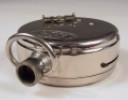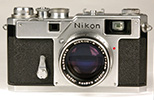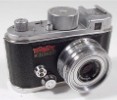
Expo Watch camera - instantaneous shutter speed. A disguised camera should be quiet.
Does the Bell & Howell Foton rapid-advance camera really sound like an ancient mechanical adding machine? Could the firing of a Minox subminiature shutter blow a spy's cover? Listen to the clicks, whirs and whines of these and other great classical cameras.
Hand tools are sensual objects. A well-designed tool integrates with our senses uniting tool and worker as one. Whether a tool is used to cook a meal, build a home, repair a car, take a photograph, our senses connect us with our tools. A carpenter's eyes watch the cutting edge of a power saw, ears know if the motor is straining, hands sense resistance in the cut, odors warn if the blade is burning the wood.
A well-made camera should be capable of taking clear, sharp, properly exposed photographs. But beyond image quality, the superior camera needs to feel right in the hand; to have the proper balance, size, weight, and even appearance. Cameras used in candid photography should not be conspicuous in operation. Many professional photographers prefer black camera bodies, thinking they are less noticeable than chrome plated cameras. Controls should be capable of adjustment with a minimum of fuss and distraction.
There are certainly a variety of criteria we can use to judge one camera superior to another, more intuitive in operation and more suitable to a given task. For many photographers, sound level is an important consideration. A number of photographic situations are benefited by the use of a quiet camera. Examples include candid, child, pet, wildlife, portrait, detective photography and certain social gatherings. Sound level might not be an issue for many sporting events, or in landscape, scenic, industrial, still-life studio, commercial, architectural photography or snapshots.
Leica cameras have a long-standing reputation of being among the quietest in their class and are often purchased for just this reason. Acceptable sound levels are relative to a camera's function and operating environment. The Foton was a loud and noisy camera, but its high speed motor drive was a solid performer.
While sound level can be an important factor to consider when choosing a
camera, camera sounds have another less obvious aspect. The sound a camera
makes when fired gives us important feedback. Many of us have
subconsciously learned the sounds our cameras make when all is well. If we
don't hear that reassuring click, we suspect we've lost the shot.
With the exception of the digital SLR, digital cameras are silent in operation. I find it interesting that so many digital cameras have an option to make a sound as the picture is taken. Some of these cameras mimic the sound of a mechanical camera shutter.
The truth is, I had fun recording the clicks and clacks of these vintage cameras. And listening and comparing the various cameras was surprisingly entertaining.
Use the audio player to hear a camera, click the thumbnail to view a camera's Web page.
The cameras are more or less, according to my ear, arranged from quietest to loudest down the page. To compare the sounds of different cameras, I suggest you start with the Expo Watch camera. Adjust your volume, and keep that volume setting as you listen to other cameras.



|
Page created January 13, 2003;
updated December 20, 2020 |